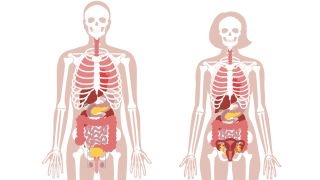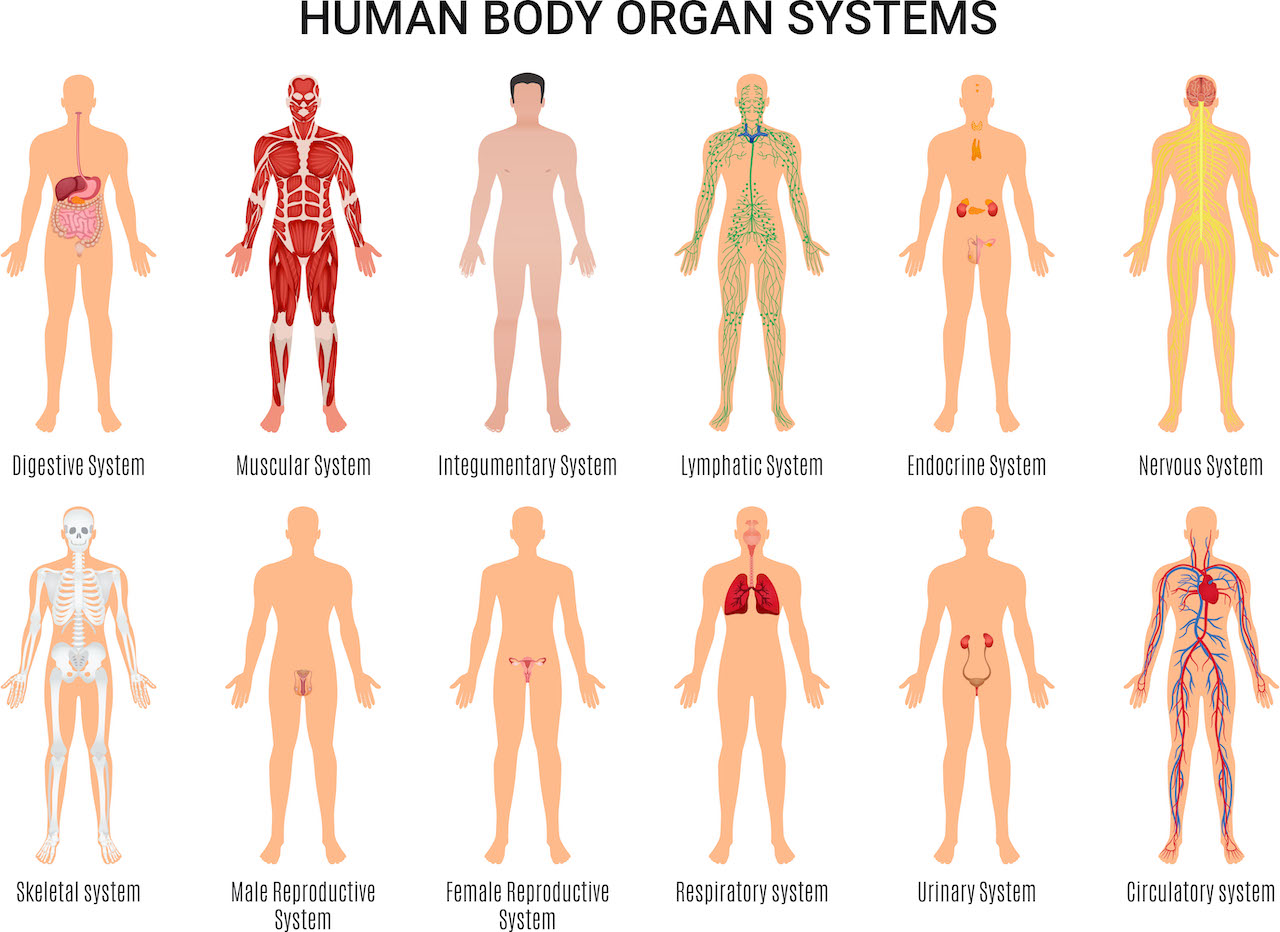How Many Heads Makeup The Human Body
The Human Trunk: Anatomy, facts & functions

The man body is everything that makes up, well, you. What decides and regulates the physical form and function of the human trunk is our genetic information, still, external environments and behaviours tin alter the style our body's look and how well they function, co-ordinate to Human Growth and Developments (opens in new tab).
The human body is made upwards of all the living and nonliving components that create the entire structure of the human being organism, including every living cell, tissue and organ.
On the outside human anatomy consists of the five bones parts, the caput, neck, body, arms and legs. However, beneath the skin there are countless biological and chemic interactions that go along the homo body machine ticking over.
Related: Trunk changes during pregnancy
What are the different systems in the man trunk?
Our bodies consist of a number of biological systems that acquit out specific functions necessary for everyday living.
The job of the circulatory system is to motility blood, nutrients, oxygen, carbon dioxide, and hormones, around the torso. Information technology consists of the eye, blood, claret vessels, arteries and veins. According to the Cleveland Dispensary (opens in new tab), the homo body's network of blood vessels, veins and capillaries is over sixty,00 miles (around 96,560 kilometres) long.
The digestive organisation consists of a serial of connected organs that together, allow the trunk to suspension down and absorb nutrient, and remove waste product. It includes the oral cavity, esophagus, stomach, small intestine, large intestine, rectum, and anus. The liver and pancreas as well play a function in the digestive system because they produce digestive juices filled with enzymes to break down the components of your food, such equally carbohydrates, fats and proteins, according to the National Institute of Diabetes and Digestive and Kidney Diseases (opens in new tab).
The endocrine organization consists of a network of glands that secrete hormones into the blood. These hormones, in turn, travel to different tissues and regulate various bodily functions, such every bit metabolism, growth and sexual role, according to Johns Hopkins Medicine (opens in new tab). For case, one of the glands in the pancreas - called the endocrine gland - releases hormones called insulin and glucagon to regulate claret sugar.
The allowed system is the trunk's defense against bacteria, viruses and other pathogens that may be harmful. The allowed system is activated when antigens (proteins on the surface of leaner, fungi and viruses) demark with receptors on immune cells, alerting the body to their presence and kicking the immune arrangement into gear, according to Institute for Quality and Efficiency in Health Care (IQWiG) (opens in new tab). The system is made upwardly of I lymph nodes, the spleen, bone marrow, lymphocytes (including B-cells and T-cells), the thymus and leukocytes, which are white blood cells.

The lymphatic system includes lymph nodes, lymph ducts and lymph vessels, and also plays a role in the trunk's defenses. Its main job is to make and move lymph, a clear fluid that contains white blood cells, which assist the torso fight infection, co-ordinate to the Cleveland Clinic. The lymphatic system likewise removes excess lymph fluid from bodily tissues, and returns it to the blood.
The nervous system controls both voluntary activeness (like conscious motion) and involuntary actions (like breathing), and sends signals to different parts of the body. The central nervous arrangement includes the brain and spinal string. The peripheral nervous system consists of fretfulness that connect every other part of the body to the central nervous arrangement, according to the National Institute of Child Health and Human being Development (opens in new tab).
Related: Fight or flight: The sympathetic nervous organisation
The body's muscular system consists of nearly 650 muscles that aid in motility, blood menstruation and other bodily functions, according to the Library of Congress. There are three types of muscle: skeletal muscle which is connected to bone and helps with voluntary motility, smooth muscle which is plant inside organs and helps to move substances through organs, and cardiac muscle which is found in the heart and helps pump blood.
The reproductive system allows humans to reproduce. The male person reproductive arrangement includes the penis and the testes, which produce sperm. The female reproductive organisation consists of the vagina, the uterus and the ovaries, which produce eggs. During conception, a sperm cell fuses with an egg cell, which creates a fertilized egg that implants and grows in the uterus.
Our bodies are supported by the skeletal arrangement, which consists of betwixt 206 and 213 bones in an adult human torso, which are all connected by tendons, ligaments and cartilage, according to the journal StatPearls (opens in new tab). As infants, humans have 270 basic, before some fuse together during growth. The skeleton non but helps us movement, simply it's likewise involved in the production of blood cells and the storage of calcium. The teeth are also part of the skeletal organization, merely they aren't considered bones.
The respiratory arrangement allows us to take in vital oxygen and expel carbon dioxide in a process we call breathing. It consists mainly of the trachea, the diaphragm and the lungs.

Related: How to increase lung capacity
The urinary organization helps eliminate a waste product product called urea from the body, which is produced when certain foods are broken down. The whole system includes two kidneys, two ureters, the bladder, two sphincter muscles and the urethra. Urine produced by the kidneys travels downwards the ureters to the float, and exits the body through the urethra.
The skin, or integumentary system, is the body'south largest organ. It protects us from the exterior earth, and is our first defense against bacteria, viruses and other pathogens. Our skin also helps regulate body temperature and eliminate waste through perspiration. In addition to skin, the integumentary system includes hair and nails.
What are the body's vital organs?
Fast facts
- The human body contains about 37.ii trillion cells.
- It'due south estimated that the microbial biome of our bodies, including bacteria and fungi is around 39 trillion cells.
- The average developed takes around 22,000 breaths a day.
- Each day, the kidneys process almost 200 quarts (50 gallons) of blood to filter out about 2 quarts of waste and water.
- Adults excrete nearly a quarter and a half (1.42 liters) of urine each solar day.
- The man brain contains virtually 100 billion nerve cells.
- Water makes up more than 50 percent of the average adult's body weight.
What are vestigial organs?
Unlike the vital organs, there are some other organs and structures within the homo body that no longer serve a purpose - known as vestigial organs. That'southward not to say that they didn't once play a part in human survival, according to the Department of Anatomy at Midwestern University (opens in new tab).
Over the course of homo evolution, some organs and anatomical structures have lost their office, for instance, the coccyx or tailbone. It was Charles Darwin that first proposed that humans descended from primates with tails, noting the tiny set of vertebrae nosotros all share adjacent to the pelvis - called the coccyx - is what remains of our bequeathed tail, according to the New York Times (opens in new tab).
Another well-known case of a seemingly functionless organ is the appendix. The appendix is a narrow pouch attached to the lower intestinal crenel of the human body. It'due south generally considered to be redundant in the part of the man body, however, in 2017 inquiry conducted past Midwestern University (opens in new tab) suggested that the appendix may serve as a reservoir for several types of benign gut bacteria.
Additional resources
- The Consummate Human Body, 2nd Edition: The Definitive Visual Guide (opens in new tab)
- Your Inner Fish: A Journey into the 3.5-Billion-Year History of the Human Body (opens in new tab)
- Inside the Human being Body (8th Edition) (opens in new tab)
How Many Heads Makeup The Human Body,
Source: https://www.livescience.com/37009-human-body.html
Posted by: smallhealf1997.blogspot.com


0 Response to "How Many Heads Makeup The Human Body"
Post a Comment